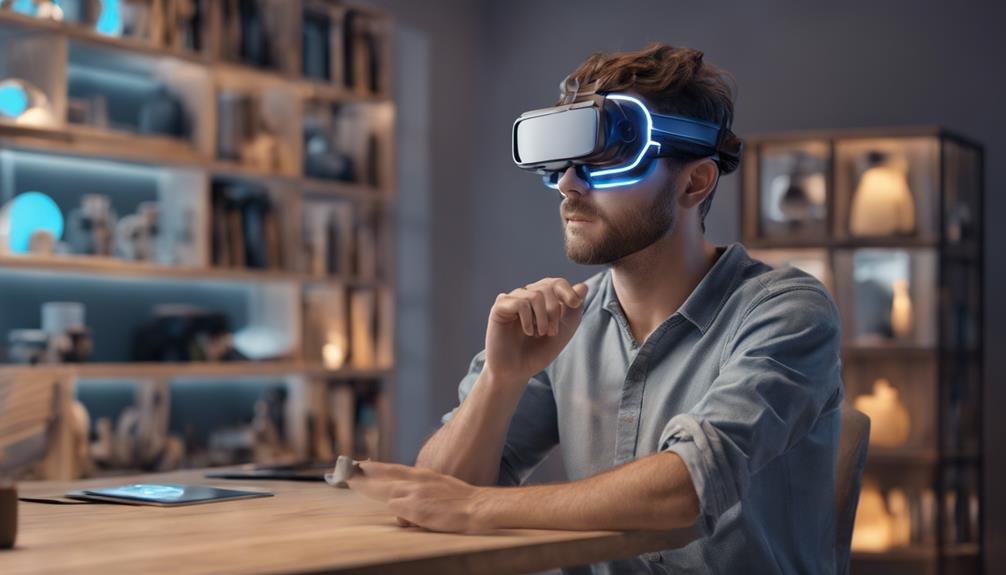Augmented Reality (AR): Definition, Examples, and Uses
Augmented Reality (AR) has been making waves across various industries, transforming how individuals interact with digital content in the physical world. This innovative technology has not only redefined user experiences but also opened up a domain of possibilities in sectors like retail, healthcare, education, and more. By seamlessly blending virtual elements with real-world environments, AR offers a unique way to engage users and enhance their interactions. The applications and potential of AR are vast, with its adaptability and versatility paving the way for groundbreaking advancements in how we perceive and interact with the world around us.
Key Takeaways
- AR overlays digital information onto the real world, enhancing user experiences.
- Examples include virtual try-ons in fashion, interactive shopping experiences, and personalized marketing.
- AR is used in healthcare for better training, surgical simulations, real-time data visualization, and improved patient care.
- Consumer products benefit from AR with enhanced user experiences, virtual try-ons, and interactive product visualizations.
- AR in education offers interactive learning, virtual classrooms, hands-on simulations, and personalized educational experiences.
Core Concepts of Augmented Reality
Augmented Reality (AR) is a transformative technology that seamlessly integrates computer-generated digital information into the real world to enhance user experiences and interactions. AR technology advancements continue to push boundaries, offering exciting prospects for future applications.
The user interface in AR plays a pivotal role in delivering interactive experiences, allowing users to engage with virtual elements in real-time. As AR evolves, the potential for innovative applications across industries becomes increasingly apparent. From enhancing educational experiences to revolutionizing how businesses engage with consumers, the immersive nature of AR holds significant promise.
The seamless integration of digital information into real-world environments opens up a myriad of possibilities, shaping the way individuals interact with technology and their surroundings.
Augmented Reality in Retail
The integration of augmented reality technology in the retail sector revolutionizes the shopping experience by offering interactive visualizations. AR in marketing allows retailers to create immersive experiences for customers, enhancing product engagement and increasing sales. In the fashion industry, AR enables virtual try-on experiences, where customers can see how clothing items look before making a purchase. This technology bridges the gap between online and physical retail, providing a unique and engaging shopping experience. AR in retail opens up opportunities for personalized marketing strategies, as retailers can tailor promotions based on customers' interactions with virtual products. Overall, augmented reality in retail showcases the potential for innovation and improved customer satisfaction in the shopping process.
| AR in Retail | Benefits | Examples |
|---|---|---|
| Enhanced Marketing | Increased Sales | Virtual Try-Ons in Fashion |
| Interactive Shopping | Personalized Experiences | AR Product Demos in Marketing Campaigns |
| Virtual Try-Ons | Improved Customer Engagement | Interactive Product Catalogs |
Augmented Reality in Healthcare
The implementation of augmented reality technology in the healthcare sector demonstrates significant potential for enhancing medical training and patient care through advanced visualizations and simulations.
- Improving Medical Training: AR offers immersive, hands-on experiences for medical students and professionals.
- Enhancing Surgical Simulations: Precise 3D models aid in practicing complex surgical procedures.
- Accurate Patient Care: AR enables real-time data visualization for better diagnosis and treatment planning.
- Reducing Errors: Virtual overlays guide healthcare providers during critical procedures.
- Enhanced Collaboration: Remote experts can provide guidance through AR technology, improving patient outcomes.
Augmented Reality in Consumer Products
One notable trend in the consumer products industry involves the integration of augmented reality technology to enhance user experiences and engagement with various products and services.
AR in fashion allows customers to virtually try on clothes, accessories, and makeup before making a purchase, reducing the need for physical changing rooms.
In home decor, AR enables users to visualize how furniture, artwork, or paint colors would look in their living spaces, aiding in decision-making and minimizing the need for physical samples.
By incorporating AR into consumer products, companies can offer interactive and personalized experiences, increasing customer satisfaction and driving sales.
This innovative use of technology transforms the way consumers interact with products, bridging the gap between online shopping and traditional retail experiences.
Augmented Reality in Education
Augmented Reality technology in education revolutionizes traditional learning methods by integrating interactive digital elements into educational experiences.
- Enhanced Interactivity: AR facilitates interactive learning experiences, engaging students in a dynamic way.
- Virtual Classrooms: AR creates virtual classrooms where students can immerse themselves in various subjects.
- Hands-On Learning: Students can engage in hands-on learning activities through AR simulations.
- Visualizations: Complex concepts are simplified through visualizations, aiding in better understanding.
- Personalized Learning: AR allows for personalized learning experiences tailored to individual student needs.
Augmented Reality in Diverse Applications
Incorporating augmented reality technology across diverse industries showcases its versatility and adaptability in modern applications.
In architecture design, AR revolutionizes the way architects and clients visualize projects by superimposing digital models onto physical spaces, aiding in better planning and decision-making.
Moreover, in tourism experiences, AR enriches sightseeing with interactive overlays of historical information, virtual guides, and immersive storytelling, enhancing tourists' engagement and understanding of their surroundings.
These applications highlight how AR transcends entertainment purposes to offer practical solutions in sectors like architecture and tourism, demonstrating its potential to transform traditional practices and elevate user experiences through innovative technological integration.
Augmented Reality Vs. Virtual Reality Vs. Mixed Reality
The distinction between augmented reality, virtual reality, and mixed reality lies in their unique approaches to blending digital and physical worlds.
- Immersive Experiences: AR enhances the real world with virtual elements, VR immerses users in entirely digital environments, and MR combines the two for a mixed experience.
- Technological Advancements: Ongoing progress in AR and VR technologies leads to more realistic and interactive experiences.
- User Interaction: AR overlays digital content onto the real world, VR isolates users in a virtual environment, and MR allows for interaction with both real and virtual elements.
- Realism: AR offers a mix of real-world and digital elements, VR provides complete digital immersion, while MR integrates virtual content into the real world.
- Future Potential: Advancements in AR, VR, and MR technologies hold promise for diverse applications and enhanced user experiences.
Conclusion
In the vast landscape of technology, Augmented Reality stands as a shining beacon, illuminating the path towards immersive and interactive experiences.
Like a painter adding strokes of color to a canvas, AR seamlessly integrates digital information into the real world, transforming ordinary interactions into extraordinary moments.
Its applications in retail, healthcare, consumer products, education, and beyond showcase its versatility and adaptability, painting a vivid picture of innovation and limitless possibilities.







